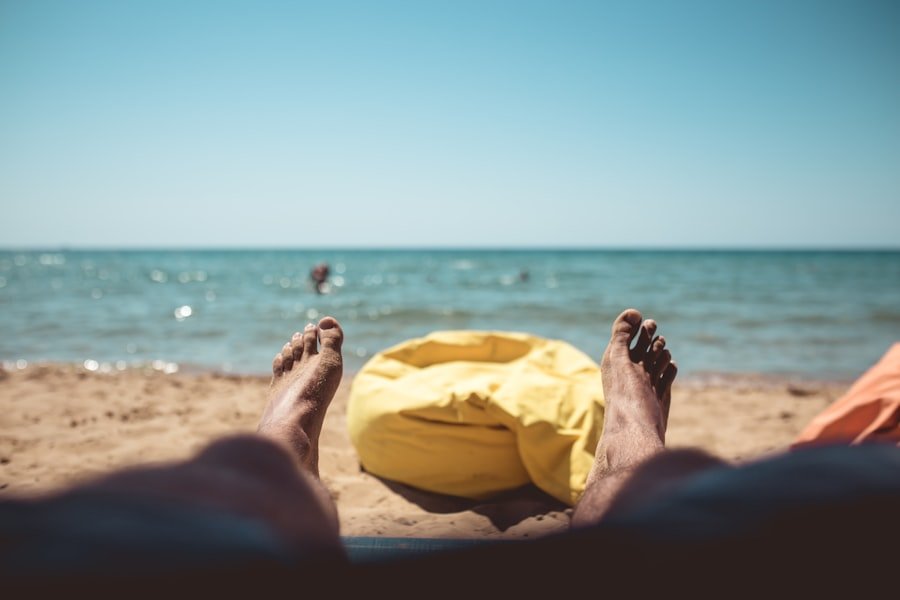Corns and calluses are thickened areas of skin that develop as a response to friction and pressure. They often appear on the feet and hands, where the skin is subjected to repeated stress. Corns are typically smaller, more localized, and often have a hard center surrounded by inflamed skin.
In contrast, calluses are larger, more diffuse areas of thickened skin that can cover a broader surface area. Both conditions serve as protective mechanisms, but they can also lead to discomfort and pain if left untreated. Understanding the nature of corns and calluses is essential for anyone who experiences foot discomfort.
These skin formations are not merely cosmetic issues; they can significantly impact our daily activities. For instance, corns often develop on the tops or sides of toes, while calluses may form on the soles of the feet or palms of the hands. Recognizing their presence is the first step toward effective management and treatment.
Key Takeaways
- Corns and calluses are thick, hardened layers of skin that develop when the skin is exposed to excessive pressure or friction.
- Causes of corns and calluses include wearing ill-fitting shoes, high heels, and engaging in activities that put pressure on the feet.
- Symptoms of corns and calluses include thick, rough, and sometimes painful patches of skin on the feet or hands.
- Diagnosis of corns and calluses is usually based on physical examination and medical history, with no need for additional tests in most cases.
- Treatment options for corns and calluses include wearing properly fitting shoes, using protective pads, and in some cases, removing the thickened skin by a healthcare professional.
Causes of Corns and Calluses
Ill-Fitting Shoes
Ill-fitting shoes are a common culprit, as they can rub against the skin and create pressure points. High heels, for example, can lead to corns on the toes due to the unnatural positioning of the foot.
Repetitive Activities
Similarly, activities that involve repetitive motion, such as running or playing certain sports, can contribute to the development of calluses on the feet or hands.
Underlying Medical Conditions
In addition to footwear and physical activities, certain medical conditions can predispose individuals to corns and calluses. For instance, people with diabetes or other circulatory issues may experience changes in their skin that make them more susceptible to these conditions. Furthermore, structural abnormalities in the feet, such as bunions or hammertoes, can also lead to increased friction and pressure, resulting in the formation of corns and calluses.
Symptoms of Corns and Calluses

The symptoms associated with corns and calluses can vary depending on their location and severity. Generally, we may notice a thickened area of skin that feels rough or hardened. Corns often present with a central core that can be painful when pressed upon, while calluses may feel less sensitive but can still cause discomfort over time.
In some cases, we might also observe redness or inflammation surrounding the affected area. As these conditions progress, we may experience increased pain or tenderness, especially during activities that put pressure on the affected area. This discomfort can interfere with our daily routines, making it challenging to walk or engage in physical activities.
Recognizing these symptoms early on is crucial for preventing further complications and ensuring effective treatment.
How to Diagnose Corns and Calluses
Diagnosing corns and calluses typically involves a physical examination by a healthcare professional. During this assessment, they will evaluate the affected areas for signs of thickened skin and any associated symptoms such as pain or inflammation. In most cases, a visual inspection is sufficient for diagnosis; however, if there are concerns about underlying conditions or complications, additional tests may be warranted.
We should also be prepared to discuss our medical history and any relevant lifestyle factors that may contribute to the development of corns and calluses. This information can help our healthcare provider determine the most appropriate course of action for treatment and prevention.
In some instances, they may recommend imaging studies or other diagnostic tests if they suspect an underlying issue that requires further investigation.
Treatment Options for Corns and Calluses
When it comes to treating corns and calluses, several options are available depending on the severity of the condition. For mild cases, we may find relief through conservative measures such as soaking our feet in warm water followed by gentle exfoliation with a pumice stone. This process helps to remove dead skin cells and reduce thickness over time.
Additionally, using over-the-counter treatments containing salicylic acid can aid in softening the hardened skin.
For more persistent or painful corns and calluses, we might consider seeking professional treatment from a podiatrist. They can provide specialized care, including debridement (removal of thickened skin) or custom orthotics to alleviate pressure on the affected areas.
In some cases, surgical intervention may be necessary to correct underlying structural issues contributing to the formation of corns and calluses.
Prevention of Corns and Calluses

Preventing corns and calluses requires a proactive approach to foot care and footwear choices. One of the most effective strategies is to wear well-fitting shoes that provide adequate support without causing friction against the skin. We should opt for shoes made from breathable materials that allow for natural movement while minimizing pressure points.
Additionally, using protective pads or insoles can help cushion areas prone to developing corns or calluses. Regular foot care is also essential in preventing these conditions. We should make it a habit to inspect our feet regularly for any signs of thickened skin or discomfort.
Keeping our feet clean and moisturized can help maintain skin health and reduce the likelihood of developing corns and calluses. Furthermore, if we engage in activities that put stress on our hands or feet, using protective gear such as gloves or padded socks can provide an extra layer of defense against friction.
When to See a Doctor for Corns and Calluses
While corns and calluses are often manageable at home, there are certain situations where we should seek medical attention. If we experience severe pain or discomfort that interferes with our daily activities, it’s essential to consult a healthcare professional for evaluation. Additionally, if we notice any signs of infection—such as increased redness, swelling, or discharge—prompt medical attention is crucial.
Individuals with underlying health conditions like diabetes should be particularly vigilant about foot care. Any changes in the appearance or sensation of our feet warrant a visit to a doctor to prevent complications. Regular check-ups with a podiatrist can help us stay ahead of potential issues related to corns and calluses.
Understanding the Difference Between Corns and Calluses
While corns and calluses share similarities as thickened areas of skin caused by friction, understanding their differences is vital for effective treatment. Corns are typically smaller and more localized than calluses; they often develop on bony prominences such as toes or joints where pressure is concentrated. The central core of a corn can be painful when pressed upon, making it essential to address them promptly.
On the other hand, calluses tend to be larger and more diffuse, forming on weight-bearing areas like the soles of our feet or palms of our hands. They usually do not have a central core and may feel less sensitive than corns. Recognizing these distinctions allows us to tailor our treatment approaches effectively based on the specific type of thickened skin we are dealing with.
Common Misconceptions About Corns and Calluses
There are several misconceptions surrounding corns and calluses that can lead to confusion about their treatment and management. One common myth is that these conditions only affect older adults; however, anyone can develop corns or calluses regardless of age due to factors like footwear choices or physical activity levels. It’s important for us to understand that these issues are not limited by age but rather by lifestyle factors.
Another misconception is that corns and calluses are purely cosmetic concerns without any real implications for health. While they may appear as minor irritations on the surface, they can lead to significant discomfort and even complications if left untreated. By debunking these myths, we can foster a better understanding of how to care for our feet effectively.
Complications Associated with Corns and Calluses
If left untreated, corns and calluses can lead to various complications that may affect our overall foot health. One potential issue is the development of infections due to cracks or breaks in the skin caused by excessive pressure or friction. This risk is particularly concerning for individuals with diabetes or compromised immune systems, as they may have reduced healing capabilities.
Additionally, persistent pain from corns or calluses can lead us to alter our gait or posture unconsciously, resulting in further musculoskeletal issues over time. This chain reaction can create discomfort in other areas of our bodies, such as our knees or hips. Therefore, addressing corns and calluses promptly is crucial not only for immediate relief but also for preventing long-term complications.
Living with Corns and Calluses: Tips for Managing Discomfort
Living with corns and calluses doesn’t have to be an uncomfortable experience if we adopt some practical strategies for managing discomfort. First and foremost, we should prioritize proper footwear choices that provide adequate support while minimizing friction against our skin. Investing in high-quality shoes designed for specific activities can make a significant difference in reducing pressure points.
In addition to footwear adjustments, incorporating regular foot care routines into our daily lives is essential. We should make it a habit to soak our feet in warm water regularly followed by gentle exfoliation with a pumice stone or foot file. Keeping our feet moisturized will help maintain skin elasticity while reducing dryness that could exacerbate discomfort from corns or calluses.
By understanding what corns and calluses are, their causes, symptoms, diagnosis methods, treatment options available along with preventive measures; we empower ourselves towards better foot health management!
If you are interested in learning more about skin health and conditions, you may want to check out this article on skin cancer detection. Understanding Corns and Calluses — the Basics is a great starting point for understanding common foot issues, but it’s also important to be aware of more serious skin conditions like skin cancer. By staying informed and educated about various skin conditions, you can take proactive steps to protect your health and well-being.
FAQs
What are corns and calluses?
Corns and calluses are thickened areas of skin that develop in response to repeated pressure or friction. They are the body’s way of protecting the skin from irritation and injury.
What causes corns and calluses?
Corns and calluses are typically caused by wearing ill-fitting shoes, walking or standing for long periods of time, or engaging in activities that put pressure on the feet.
Where do corns and calluses commonly develop?
Corns often develop on the tops and sides of the toes, while calluses typically form on the soles of the feet, particularly under the heels or balls of the feet.
How can corns and calluses be prevented?
Corns and calluses can be prevented by wearing properly fitting shoes, using protective padding or insoles, and keeping the feet clean and moisturized.
How are corns and calluses treated?
Treatment for corns and calluses may include wearing cushioned pads, using over-the-counter treatments to soften the skin, and in some cases, having them removed by a healthcare professional.


